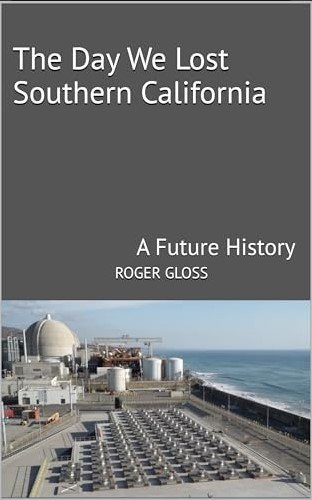Just When You Thought It Was Safe to Live in L.A.
Reviewed by Mary Beth Brangan, James Heddle, EON
Published on October 07, 2024
A Review of The Day We Lost Southern California, By Roger Gloss Source
An Enlightening “Future History”
Set in the year 2032 and told through the eyes of fictional newspaper journalist Michael Powell of the ‘East Bay Times,’ novelist Roger Gloss’s prescient cautionary tale opens with Powell’s dispatch covering a State-of-the-State speech by Governor Teresa Morales.
Her address is given on March 24 of that near-future year “exactly six months from the catastrophic explosion at the decommissioned San Onofre Generating Station (SONGS)… with wide-ranging and devastating consequences that have plunged California and the nation into unprecedented chaos.”
In a powerful and dramatic, yet slim volume of just 21 pages, novelist Gloss has penned a stark, evidence-based speculative narrative of a very possible near-future event designed to catalyze preventative official and public action in time.
In an introductory note, Gloss affirms,
“The intent of this ‘future history’ is not to frighten readers, although that might be a useful side effect. Rather, I hope that by laying out a kind of worst-case scenario to alert local government officials, local environmentalists and the broader public to the looming threat of lethal nuclear waste currently sitting in our own backyard, as well as enlist passionate support at all levels at meaningful steps to manage it.”
Gloss is the author of six published novels, including his latest, New California, currently available on Amazon. His website is here.
A Reality-Based, Accurate Situational Analysis
Framed as retrospective eye-witness accounts by main character, reporter Powell and his key informant, Neal Prakash - the evacuated Mayor of Irvine - Powell’s narrative is grounded in the actual, existing facts-in-and-on-the-ground at San Onofre.
“The nuclear waste from the shuttered power plant was stored in 135 thin-walled steel canisters. To break this down, 62 canisters were … were first deployed starting in 2003, while SONGS was still generating power. These canisters were stored horizontally, above ground.
“After the plant was shuttered in 2013, more spent fuel rods were transferred from the cooling ponds to 73 canisters manufactured by Holtec. The Holtec canisters are a mere 5/8-inch and do not meet ASME (American Society of Mechanical Engineers) standards for nuclear pressure vessels. Southern California Edison was granted a waiver by the federal NRC to use these canisters. They are stored vertically in vented siloes, only partially below ground, and even closer to the shoreline than the NUHOMS array. They are subject to through-wall cracks caused by corrosion, and there was no way to inspect them, repair them, or move them to a safer location. A breach was inevitable at ‘some point’ (very likely within the 25-year implied by the manufacturer’s warranty,) along with the Chernobyl-style release of deadly radiation – notably Cesium-134, Cesium-137, Plutonium 239 and more – that resulted from just a single canister. It was a no-brainer for materials scientists and nuclear experts to surmise that stormwater and/or seawater flooded the canister area and either clogged the cooling air vents of at least one canister, penetrated a developing through-wall crack or both. From recent drone footage (humans cannot go near the site) it appears that the explosion in turn caused a breach of several nearby canisters, triggering the release of still more radiation, spreading it more rapidly and widely. So, four more Chernobyls, more or less….
“To give more perspective, the 1986 Chernobyl disaster created an exclusion zone of 1000 square miles, which ironically, nearly matches Orange County 948 square miles….
“Anyone living within 50 miles or more of ground zero would be under threat – more than ten million people in Orange, Los Angeles, and San Diego Counties. The entire region could potentially become a no-man’s land unfit for human habitation – all residential and commercial properties condemned and unusable. At a bare minimum, all of Orange County fell within the exclusion zone. Everything that made Southern California desirable – the beaches, the mountains, world class colleges and universities, venues of art, culture, entertainment and recreation, even Disneyland – much of it forever off limits.”
In Powell’s account, the Governor estimated property losses at a total of $20 trillion. Not to mention the human trauma and human suffering, which Powell and his wife experienced themselves, losing their home, which no insurance covered, and having to relocate with family in Oakland. He reports,
“The entire population – millions of people – needed to be evacuated immediately, but of course, that was impossible, and local police, sheriff and emergency services had no plan to do so. Everyone was on their own to evacuate….”
Powell’s report continues,
“While struggling to evacuate in the hours and days following the explosion, many suffered from radiation sickness – chronic fatigue, nausea, loss of appetite. Longer term, radiation exposure causes cancer of all kinds, so the bulk of the population that evacuated are also at risk of future illness and shorter lifespan.”
We invite you to explore the rest of author Gloss’s realistic and enlightening narrative yourself - including his key informant, Irvine Mayor Neal Prakash’s description-from-exile of post-disaster conditions in his abandoned city, including squatting in deserted houses by homeless, impoverished and displaced disaster victims from elsewhere, the looting, toxic environment and high crime levels experienced by those unwilling or unable to evacuate the once idyllic, model planned community of Irvine.
It is not a pretty picture that Gloss’s sobering ‘future narrative’ gives us, but a potentially life-and property-saving wake-up call for those with the courage to confront and act upon its warnings.
It is a valuable public service for which readers should be grateful. We recommend it highly.
Mary Beth Brangan and James Heddle co-direct EON, the Ecological Options Network. The multi-award winning EON feature documentary SOS – The San Onofre Syndrome: Nuclear Power’s Legacy, was chosen as the opening film in the 13th annual Global Nonviolent Film Festival, where it also received the Organizers’ Award for ‘BEST ACTUALITY SUBJECT – Feature Documentary’, and is available for viewing worldwide.
The film was directed by Brangan, Heddle. and Morgan Peterson, who also served as editor. SOS is a transgenerational co-creation of two senior filmmakers and a millennial mom with two young daughters. For information, please visit the SOS website.

